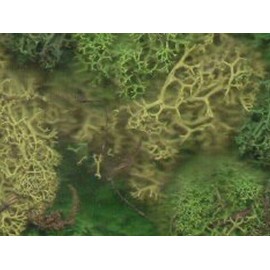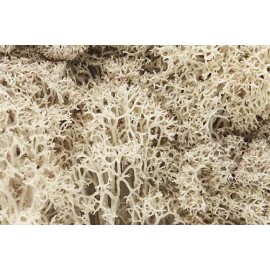Static grass puffer bottles work by manually charging model grass fibres with static electricity. When the charged...
No products
Product successfully added to your shopping cart
There are 0 items in your cart. There is 1 item in your cart.
Search Tips
What is lichen?
Lichen is a versatile and natural material often used in modelling to recreate realistic landscapes, particularly when depicting trees, bushes and other forms of ground cover. You may have encountered it in dioramas or model railway setups, where the goal is to bring a sense of authentic, rugged scenery to a miniature world. Its texture, appearance and flexibility make it ideal for imitating the organic feel of foliage, as it can easily represent dense shrubbery, moss or undergrowth when appropriately coloured and shaped.
If you’re looking to add realism to your model, lichen offers several benefits. Unlike plastic foliage or synthetic fibres, it has a natural irregularity that can be difficult to replicate with artificial materials. This organic irregularity, combined with a variety of natural colours, can make a scale model look much more realistic. Additionally, because it is a natural product, lichen is biodegradable and often sustainably harvested, making it an environmentally conscious choice.
One of the appealing aspects of lichen is how it can be easily adapted to suit different scales and environments. For instance, small clusters of lichen can be used to create bushes in OO gauge and wargaming terrains. On a larger scale, you can shape and position it to suggest sprawling forests or thickets, offering a sense of depth and variety to the landscape. With a little imagination and some trimming, you can make it fit various natural scenes, from dense jungles to sparse, arid terrains.
Colouring lichen is also quite straightforward, which allows for additional customisation. You can use a range of model-safe dyes and paints to achieve the desired hue for different scenes or seasonal effects, whether it’s a spring-green forest, a dry summer shrub or an autumnal landscape. Spray paints, in particular, can be useful for quickly adding colour while maintaining the delicate texture of the lichen. Just ensure you use paint sparingly, as heavy coatings can sometimes stiffen the material, making it less flexible for placement and arrangement.
The flexibility of lichen is another major benefit, allowing you to bend, twist and layer it to create various natural effects. If you’ve ever used synthetic materials, you might find that they can be quite rigid, limiting their placement options. Lichen, on the other hand, holds its shape well while remaining pliable, so you can manipulate it to fit tight spots on your diorama or wrap it around structures without it looking unnatural. This pliability also means it can adhere well to different surfaces with minimal adhesives, ensuring it stays securely in place.
However, like any organic material, lichen does have some limitations. Without proper care, it may dry out over time, potentially becoming brittle and losing some of its vividness. To extend its lifespan, some modellers recommend treating it with a preservative spray or occasional misting with water. If you’re planning a long-term display, investing in quality-preserved lichen can offer added durability, ensuring your model maintains its lifelike appearance for years.
Overall, lichen is an excellent choice for modellers aiming for authenticity in their landscapes. It can bring a touch of natural texture and depth that enhances the visual appeal of a scale model, especially if you’re creating dioramas or railway scenes with intricate details.
Click here to receive the tips weekly in your mailbox. You can unsubscribe at any time.










